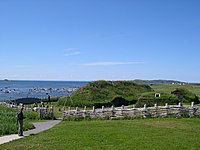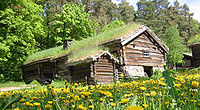Difference between revisions of "Rooftop farming"
| Line 12: | Line 12: | ||
The Palazzo Piccolomini<ref>[http://en.wikipedia.org/wiki/Palazzo_Piccolomini#Palazzo_Piccolomini Pienza, section Palazzo Piccolomini] Wikipedia</ref> was the private summer residence of Pope Pius II. The city of Pienza where the palazzo is located was one of the first examples of Renaissance town planning. Atop Pius II's palazzo was a magnificent roof garden filled with sculpted trees.<ref name="heathershimmin">[http://www.heathershimmin.com/a-brief-history-of-roof-gardens A brief history of roof gardens]</ref> | The Palazzo Piccolomini<ref>[http://en.wikipedia.org/wiki/Palazzo_Piccolomini#Palazzo_Piccolomini Pienza, section Palazzo Piccolomini] Wikipedia</ref> was the private summer residence of Pope Pius II. The city of Pienza where the palazzo is located was one of the first examples of Renaissance town planning. Atop Pius II's palazzo was a magnificent roof garden filled with sculpted trees.<ref name="heathershimmin">[http://www.heathershimmin.com/a-brief-history-of-roof-gardens A brief history of roof gardens]</ref> | ||
| − | "A sod roof or turf roof is a traditional Scandinavian type of green roof covered with sod on top of several layers of birch bark on gently sloping wooden roof boards. Until the late 19th century, it was the most common roof on rural log houses in large parts of Scandinavia."<ref>[http://en.wikipedia.org/wiki/Sod_roofs Sod roofs] Wikipedia< | + | "A sod roof or turf roof is a traditional Scandinavian type of green roof covered with sod on top of several layers of birch bark on gently sloping wooden roof boards. Until the late 19th century, it was the most common roof on rural log houses in large parts of Scandinavia."<ref>[http://en.wikipedia.org/wiki/Sod_roofs Sod roofs] Wikipedia</ref> |
---- | ---- | ||
From: | From: | ||
Revision as of 18:12, 23 July 2012
- Topic in Gardening courses. By John Eagles.
- This page is under construction
History
Between ca 200 to ca 500 BCE there were built the ancient ziggurats or temple towers of ancient Mesopotamia. The oldest of these constructions were sun-dried brick towers had stepped terraces with a temple at its summit. Archeologists have discovered that large trees had been planted on the upper terraces of the towers.[1].
King Nebuchadnezzar II who ruled between 605 and 562 BC built the Hanging Gardens of Babylon.[2] The gardens were built for his wife, Amytis of Media, who longed for the plants of her homeland. Acoording to estimates the gardens would have required at least 37,000 liters of water per day.
Roof gardens must have been an essential part of Roman life in Pompeii. One such roof garden was found in the Villa of Mysteries.[3]
The Palazzo Piccolomini[4] was the private summer residence of Pope Pius II. The city of Pienza where the palazzo is located was one of the first examples of Renaissance town planning. Atop Pius II's palazzo was a magnificent roof garden filled with sculpted trees.[5]
"A sod roof or turf roof is a traditional Scandinavian type of green roof covered with sod on top of several layers of birch bark on gently sloping wooden roof boards. Until the late 19th century, it was the most common roof on rural log houses in large parts of Scandinavia."[6]
From:
http://www.heathershimmin.com/a-brief-history-of-roof-gardens
Norwegian Sod Roofs Not all roof gardens were designed to impress. Sod roofs, roofs topped with soil and planted with grasses and other plants to stabilize the earth on the roof, were part of the Norwegian vernacular. Sod roofs provided insulation, mitigated damage to the roof from the rain, prevented the roof from rotting, and the root system bound and strengthened the roof structure. A layer of birch bark was laid down as a sealing membrane, followed by a layer of twigs for drainage, then covered in sod. A similar sod roof technique was brought to the United States and Canada by Norwegian immigrants. Norwegian sod roof A sod roof in Milton, North Dakota, built by Ole Myrvik, a Norwegian Immigrant, c. 1896. Sod roofs were common in Norway because they added an additional layer of insulation and protection to the house. Norwegian immigrants brought the technique with them to the US and Canada. Casino Theatre, New York City Gardens on rooftops started popping up in New York City in the 1890s. Investors believed roof gardens would overshadow all other forms of summer entertainment and would become a necessity part of life for New Yorkers. The first roof garden in New York City was built on the Casino Theatre at 39th and Broadway in 1882. This project was conceived by conductor and musician Rudolph Aronson, who was enchanted by the Parisian summer theatre gardens he had experienced during his visit to Europe the previous summer. The price of land in New York was too expensive to duplicate the European garden stage model on the ground, so Aronson incorporated the idea of a stage surrounded by plants and trees on the roof. By adding the roof garden, the Casino Theatre could extend its productions all through the summer months in the heart of New York’s theatre district. At this time, theatres in New York would only run during the winter months. Summer theatres would open in the suburbs and less populated areas in the state. The Casino Theatre quickly became the most successful theatre in New York, spurring other theatres to add gardens to their roofs. The most well known examples are Madison Square Gardens and WInter Gardens, both of which get their names from their roof gardens. casino theatre new york The Casino Theatre, New York City, as seen on a postcard stamped March 1909. The Casino Theatre was the first theatre to install a roof garden in New York City, extenting its shows through the summer months. Wright, Le Corbusier, & Modern Architecture Architecture changed dramatically in the early 20th century. Modernists such as Frank Lloyd Wright and Le Corbusier broke free from the bonds of historical architecture, introducing a completely new form of design that had no reference to the past. Le Corburiser’s Cinq Points de l’Architecture Moderne became the new model for architectural design and theory. The 5th Point, the roof garden or terrace, was a flat roof intended to be an outdoor living room, a place to exercise and to enjoy the fresh air, rather than a literal garden with plants and trees. Le Corbusier considered the roof to be an “exterior room, a place to be within and to look without.” Modern architecture’s flat roof provides the perfect platform on which to build a vegetated roof. In the 1930s, Le Corbusier was brought on as a consultant on two projects in Brazil – the Ministry of Education building in Rio de Janeiro (1938) and the Brazilian Press Association building (1940) – where landscape architect Roberto Burle Marx designed the roof gardens. MORE ON ROOF GARDENS
Gallery
See also
References
- ↑ The history of roof top design
- ↑ Hanging Gardens of Babylon Wikipedia
- ↑ Villa of the Mysteries Wikipedia
- ↑ Pienza, section Palazzo Piccolomini Wikipedia
- ↑ A brief history of roof gardens
- ↑ Sod roofs Wikipedia
External links
- A brief history of roof gardens
- Green roof Wikipedia
- Green roof photos
- Greenroofs.com
- Kensington Roof Gardens Wikipedia
- National Geographic Green Roofs Photo gallery
- Roof garden Wikipedia
Comments
- You need to be logged into your Facebook account to post comments










